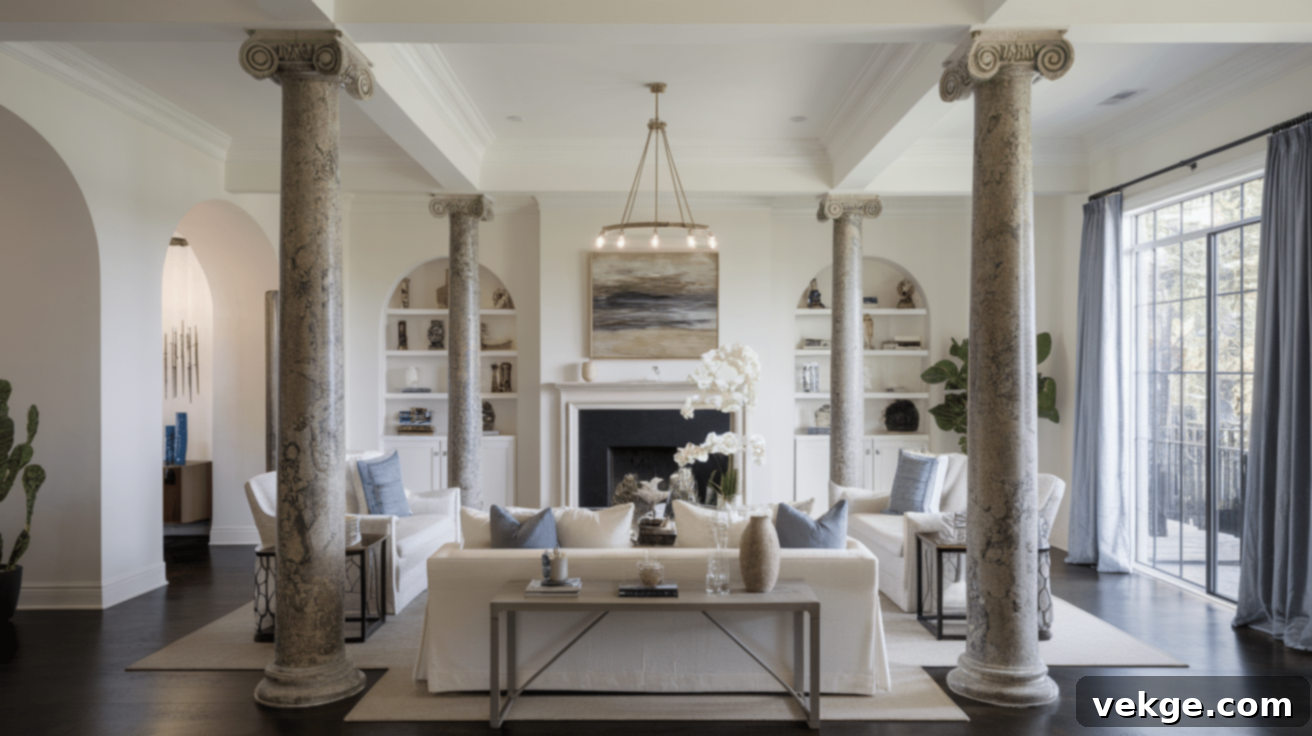Transform Your Home with Interior Columns: Design Ideas & Expert Tips
Are you navigating an open floor plan that feels disjointed, lacks clear zones, or simply needs an architectural anchor? Interior columns could be the perfect solution to your design dilemmas. These versatile architectural elements are far more than just structural supports; they are powerful design tools that can inject style, character, and much-needed definition into any living space. From subtly separating areas in a large room to creating a dramatic focal point, columns offer endless possibilities for enhancing your home’s aesthetic and functionality.
In this comprehensive guide, we’ll delve into the fascinating world of interior columns. We’ll explore various types of columns, from classic wood to sleek modern designs, and uncover creative ways to integrate them into every room of your home. We’ll also discuss how to select the ideal materials and finishes to complement your existing decor and practical considerations for placement and installation. Whether you’re looking to transform a sprawling living area or simply add a touch of elegance, understanding how to effectively use columns can dramatically elevate your home’s appeal. Keep reading to discover how these seemingly simple elements can profoundly reshape and refine your interior spaces.
Types of Interior Columns
Interior columns come in a diverse array of styles, materials, and designs, ensuring there’s a perfect match for virtually any home theme, from rustic farmhouse to ultra-modern minimalist. Each type brings its unique charm and can serve both essential structural functions and significant decorative purposes. The right column choice depends heavily on your home’s overall architectural style, the specific function of the room, and your personal design preferences. Let’s explore some of the most popular types:
1. Wooden Columns
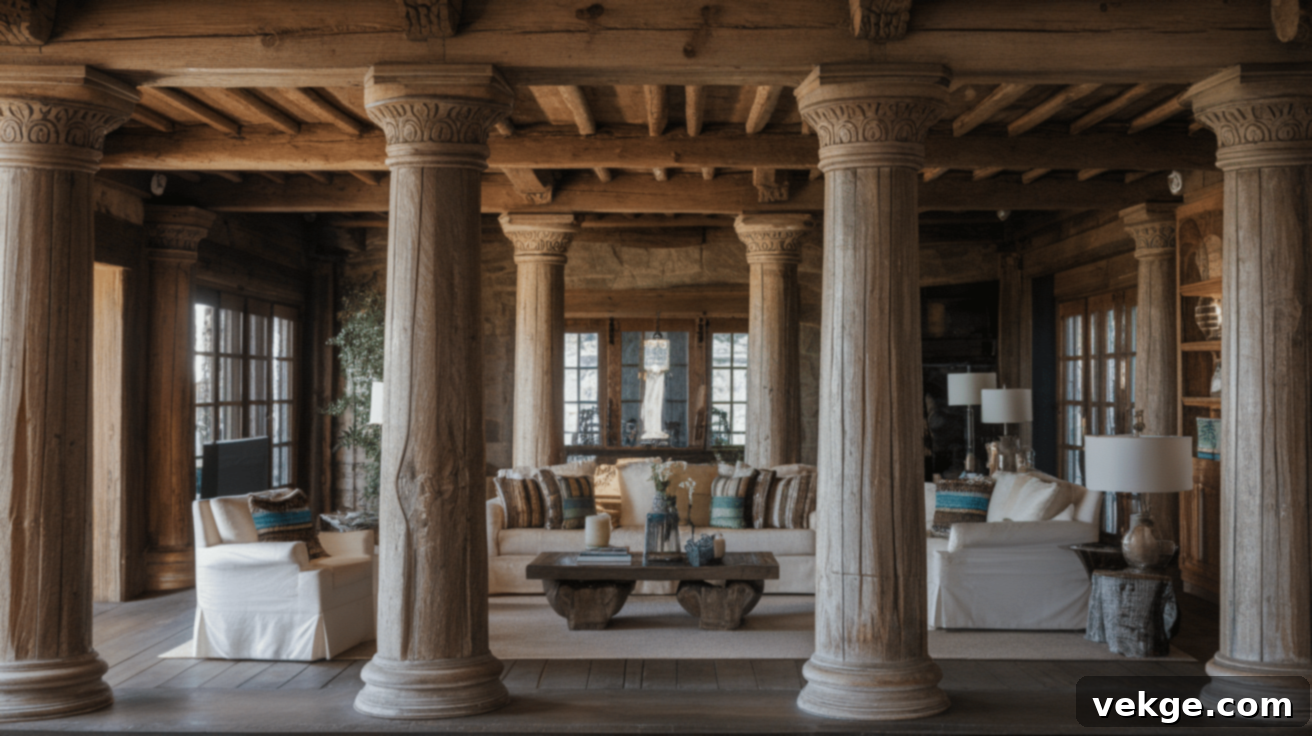
Wooden columns exude warmth, natural charm, and timeless elegance, making them a superb choice for homes embracing traditional, rustic, or even transitional decor. Crafted from solid wood, these columns often showcase intricate carvings, turnings, and rich, visible grain patterns that speak volumes about skilled craftsmanship. Materials like oak, cherry, maple, and pine each offer distinct visual characteristics and can be stained to match existing wooden floors, furniture, or trim. They are particularly effective in entry halls, grand living rooms, and formal dining areas, where their robust presence and classic appeal create a cohesive and inviting atmosphere.
2. Faux Wood Columns
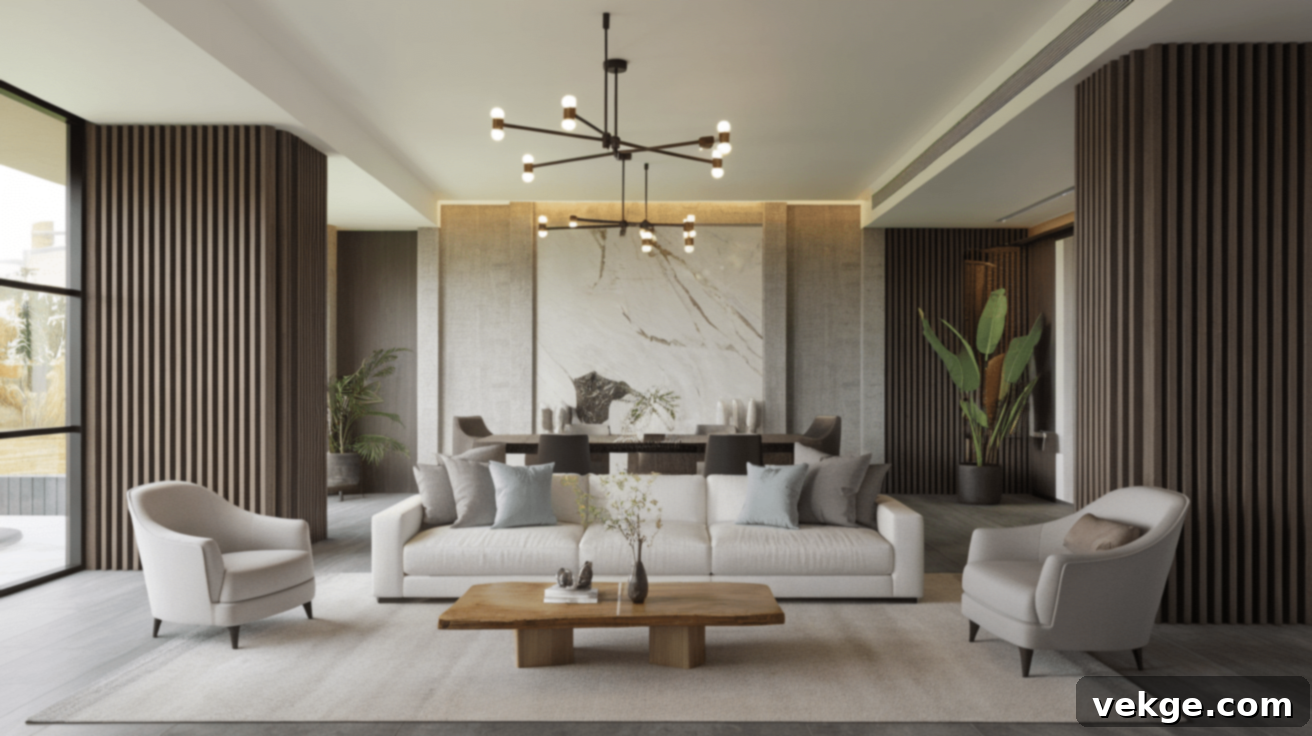
For those who admire the aesthetic of real wood but seek enhanced durability, lower maintenance, or a more budget-friendly option, faux wood columns are an excellent alternative. Manufactured from advanced materials such as PVC, polyurethane, or high-density composite, these columns are engineered to resist common issues like moisture damage, insect infestations, and warping. They offer the visual impact of natural wood without the typical upkeep, and their lighter weight often simplifies installation, making them a practical choice for a wide range of modern and traditional homes. Faux wood columns can also be painted or stained to achieve a desired finish, providing immense design flexibility.
3. Fluted Columns

Fluted columns are characterized by their distinctive vertical grooves, or flutes, running along their entire length. These classic design elements originated in ancient Greek and Roman architecture and continue to add a profound sense of texture, visual interest, and historical formality to any room. The interplay of light and shadow across the flutes creates dynamic visual effects that change throughout the day, giving the column a sense of depth and movement. Ideal for more formal settings, grand entryways, or as decorative accents, fluted columns can elevate a space, providing an air of sophisticated elegance and structured order.
4. Square Columns
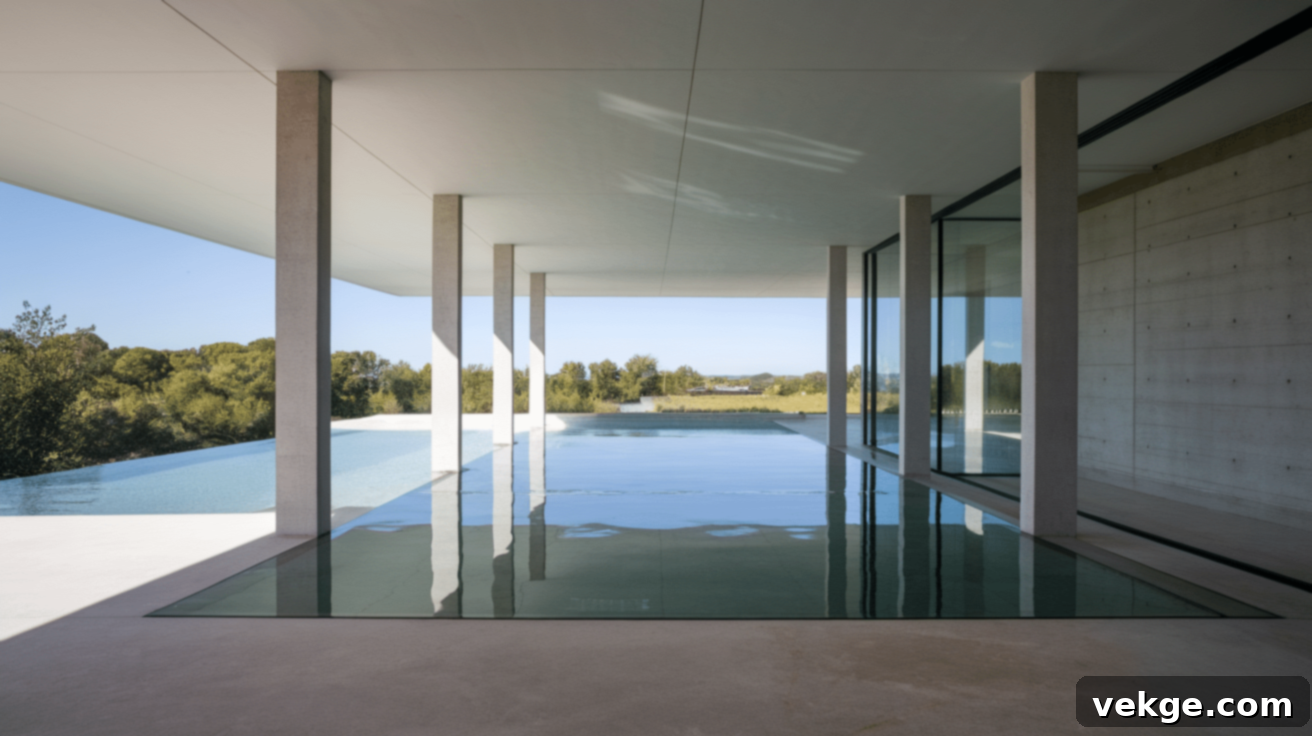
Square columns are celebrated for their clean lines, sharp angles, and sleek, minimalist aesthetic, making them a perfect fit for contemporary, modern, and industrial-style homes. Their simple, geometric shape seamlessly integrates with current design trends, creating clear visual boundaries and a sense of understated sophistication. These versatile columns can be crafted from an extensive array of materials, including wood, metal, stone, or even drywall, allowing for diverse textural and color possibilities. Their straight edges and unfussy details help to define spaces without adding visual clutter, contributing to an uncluttered and refined interior.
5. Decorative Pillars
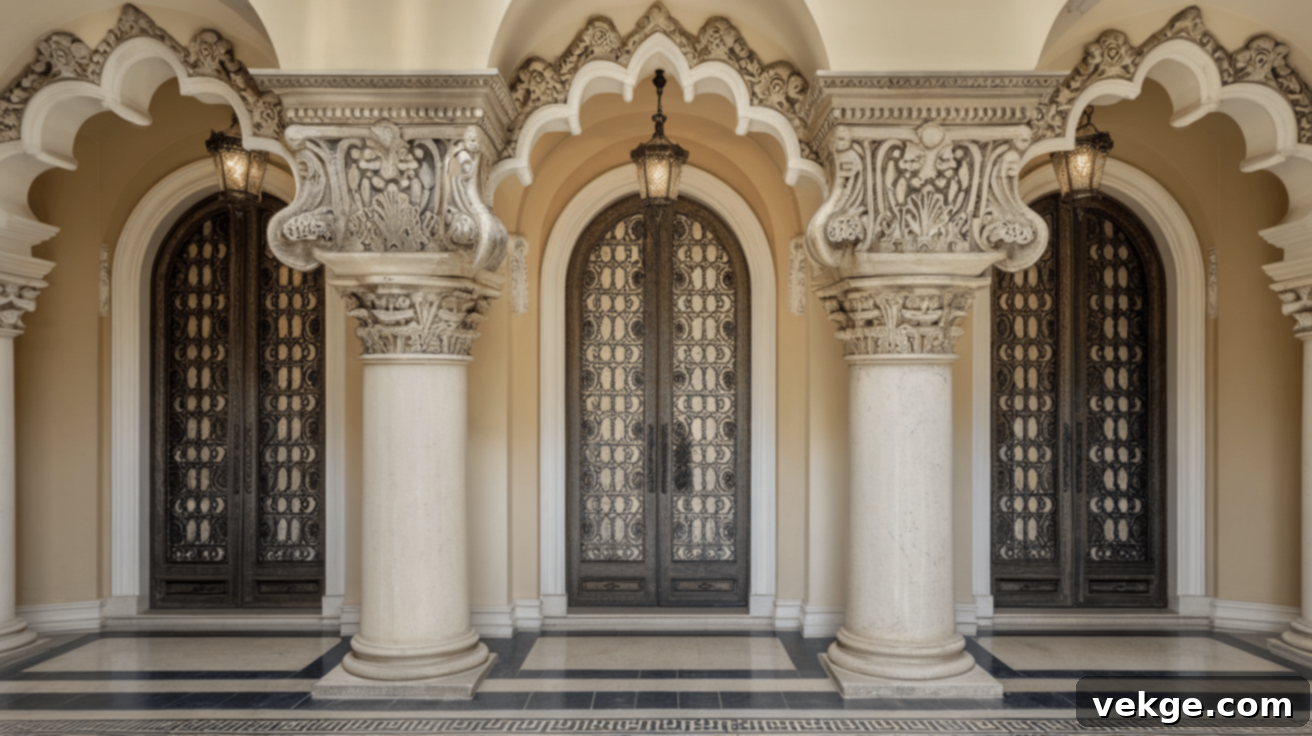
Unlike strictly structural columns, decorative pillars are primarily chosen for their striking visual impact and aesthetic appeal. These elements serve as artistic focal points, adding grandeur and character to a space. They often feature highly ornate capitals (the top section), intricately detailed bases, and embellished middle sections that may include carvings, inlays, or specialized finishes like faux marble or distressed wood. Homeowners frequently use decorative pillars to emphasize entryways, frame specific architectural features, or create elegant visual anchors in expansive rooms, transforming an ordinary space into something truly extraordinary.
Creative Interior Column Ideas
Columns are much more than just vertical supports; they are opportunities to enhance your living spaces with both style and purpose. Here’s a collection of practical and imaginative ways to integrate interior columns into your home, transforming them from mere architectural necessities into compelling design features:
1. Columns as Room Dividers
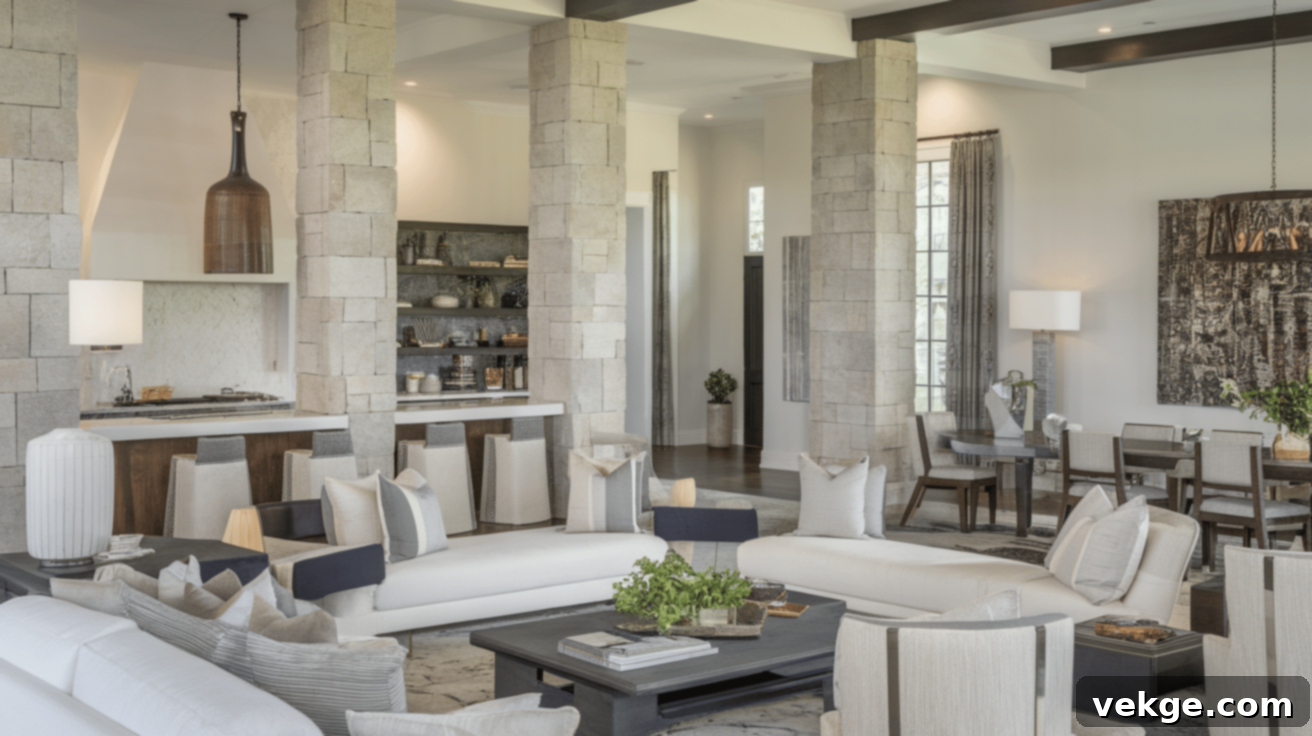
Columns excel at creating subtle yet effective divisions between living areas while preserving the open, airy feel of a modern floor plan. Unlike solid walls that block light and views, a pair of strategically placed columns can define separate zones—such as distinguishing your living room from the dining area or framing a grand entryway—without sacrificing visual flow. They offer structural definition, making open spaces feel more organized and purposeful, allowing for distinct areas for different activities while maintaining an interconnected ambiance. Consider minimalist square columns for a contemporary division or classic fluted columns for a more formal separation.
2. Decorative Columns in Entryways

The entryway is the first impression your home makes, and decorative columns can ensure it’s a lasting one. They beautifully frame your foyer, instantly establishing your home’s design theme and setting the tone for what lies beyond. Whether used in pairs to mark a grand entrance or as single statement pieces, these columns add structure, formality, and a sense of importance to transitional spaces. For maximum impact, select a column style that perfectly complements other architectural elements, such as crown molding or door frames, to create a cohesive and welcoming threshold.
3. Columns Framing a Fireplace
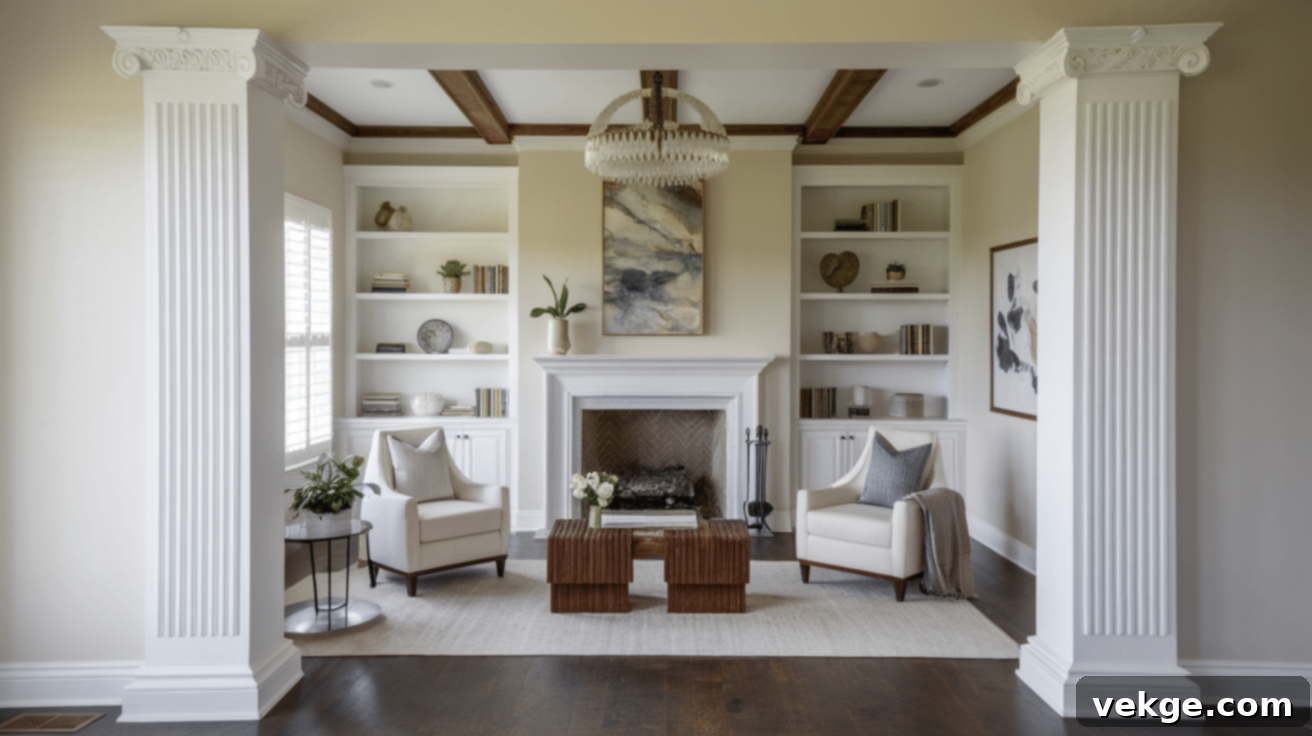
Flanking your fireplace with a pair of elegant columns creates a classic and captivating focal point that immediately draws the eye. This symmetrical arrangement brings balance and structure, elevating the fireplace from a mere heat source to a prominent architectural feature. The vertical lines of the columns naturally guide the eye upward, giving the illusion of higher ceilings and enhancing the room’s grandeur. This timeless pairing works equally well with both traditional and modern fireplace designs, adding a touch of sophisticated formality and warmth to your living space.
4. Incorporating Columns in Living Rooms
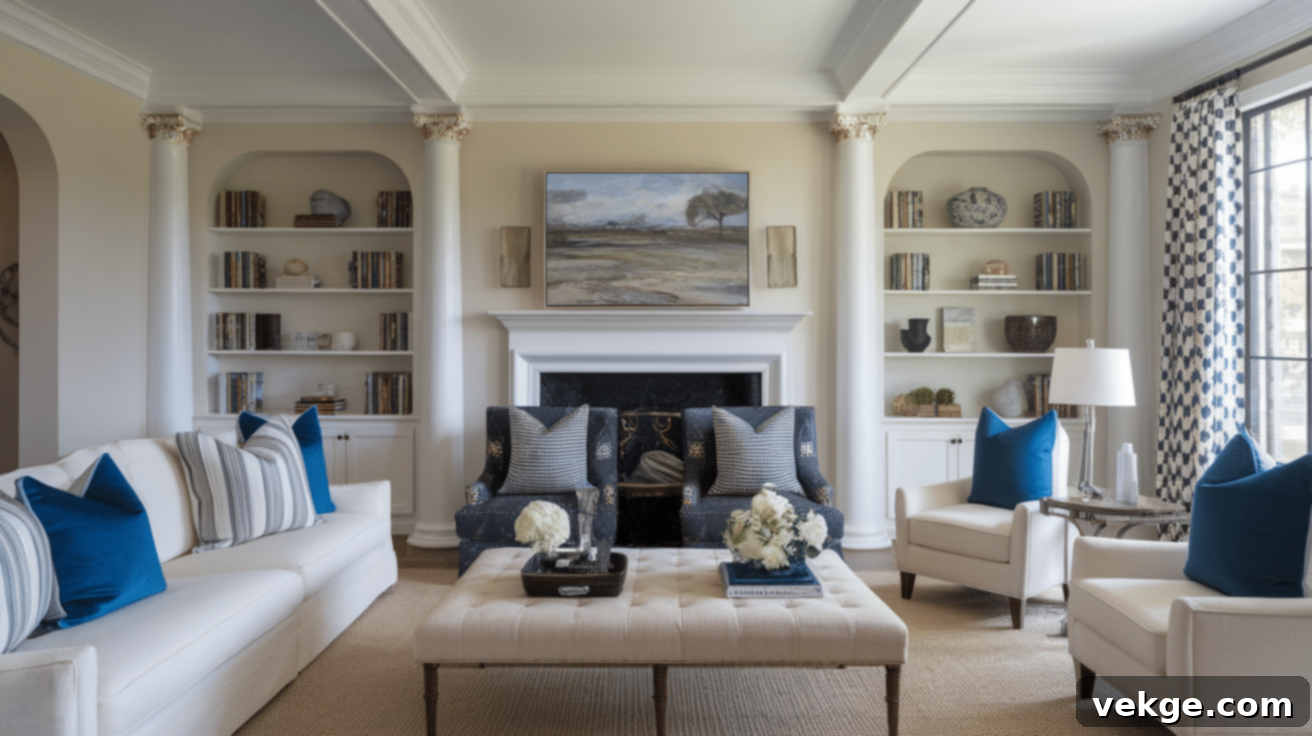
In living rooms, columns can be treated as significant design assets. Paint them to match your walls for a subtle, integrated look, or use contrasting colors or textures to make them pop as visual statements. Consider wrapping them in materials such as stone veneer, reclaimed wood, or patterned wallpaper to complement your furniture and overall decor scheme. Thoughtfully arrange seating to work harmoniously with column placement, perhaps using them to define cozy conversation areas or to anchor a sophisticated reading nook. They add a structural rhythm that enhances the room’s layout and flow.
5. Columns in Dining Rooms
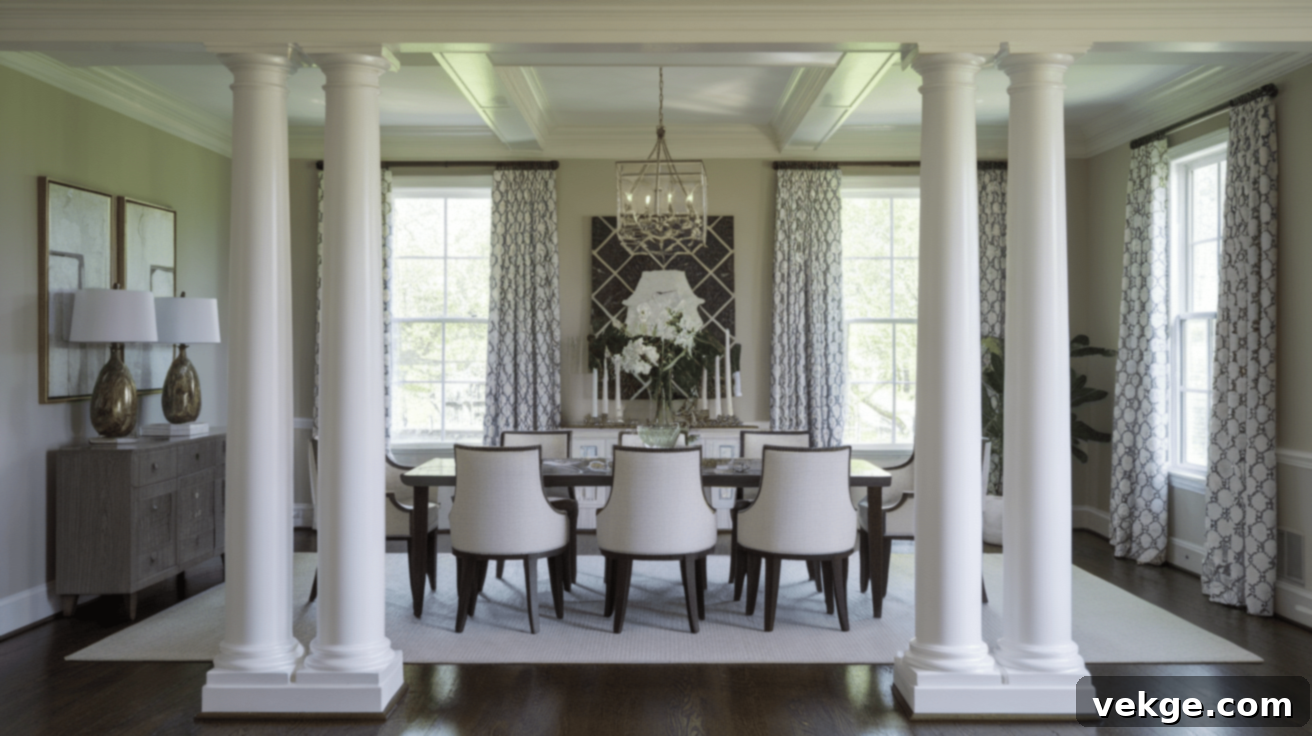
Dining room columns introduce a sense of structure and formality that perfectly suits eating spaces. They can elegantly frame a large dining table, creating a distinct “room within a room,” or serve to subtly separate the dining area from adjacent spaces in open-concept homes. By defining the dining zone, columns help to designate it as a special and intentional area, distinct from everyday living spaces. Their style, whether grand and ornate or sleek and simple, can echo details from your dining furniture or cabinetry, contributing to a cohesive and meticulously planned aesthetic.
6. Adding Columns to the Kitchen
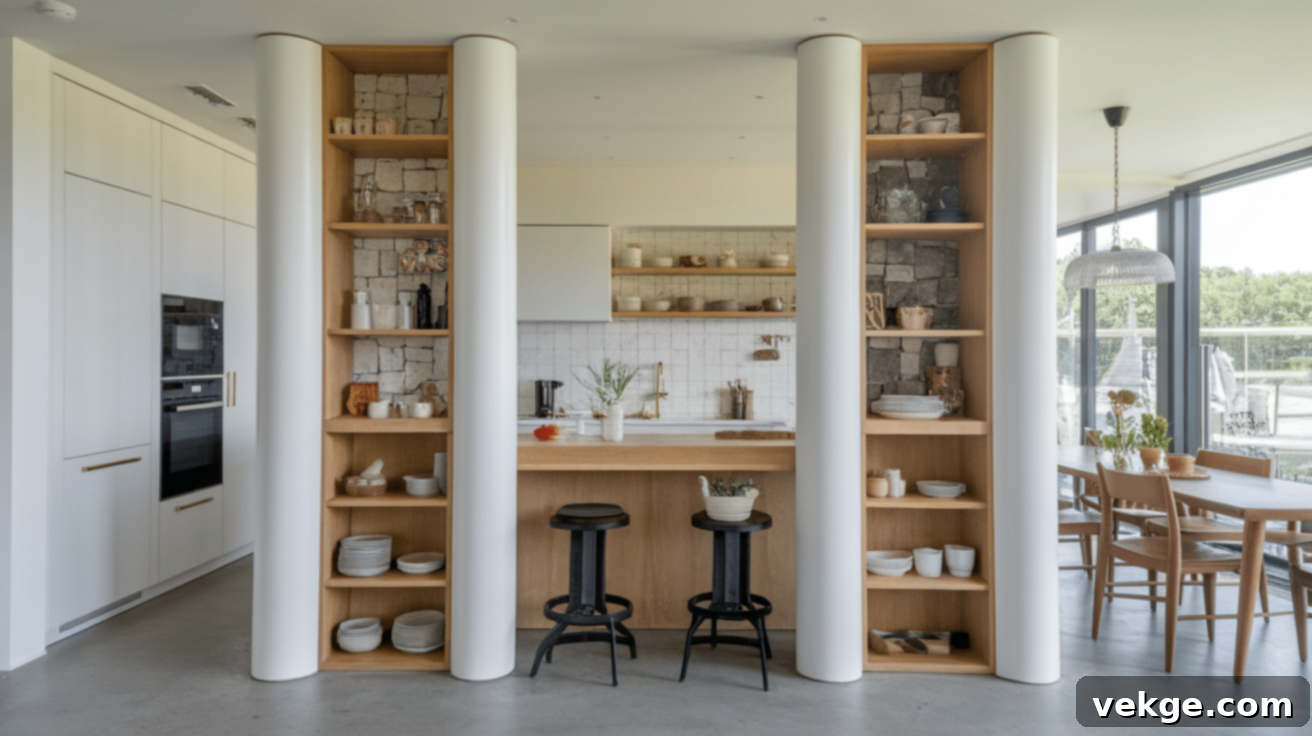
Kitchen columns offer both practical utility and visual appeal. They can effectively mark the transition between cooking zones and casual eating areas, such as a breakfast nook or an island with seating. Beyond mere aesthetics, columns can be ingeniously designed to support extended countertops, overhead cabinets, or even house built-in features like spice racks, wine storage cubbies, or dedicated nooks for small appliances. Matching their finish to your existing cabinetry creates a seamless, built-in, and custom appearance that enhances both the style and efficiency of your kitchen.
7. Columns in Home Offices

In today’s multipurpose homes, office columns are invaluable for creating distinct and focused work zones. They can clearly separate a dedicated desk area from a meeting space within a larger room, or establish a psychological boundary between your professional activities and home life. Consider integrating columns into the office layout by building custom desks or shelving units directly between them, effectively transforming structural elements into highly functional workspace features. Clean, simple column designs, often in neutral tones, tend to work best in productive environments, promoting focus and a sense of order.
8. Columns as Shelving Units
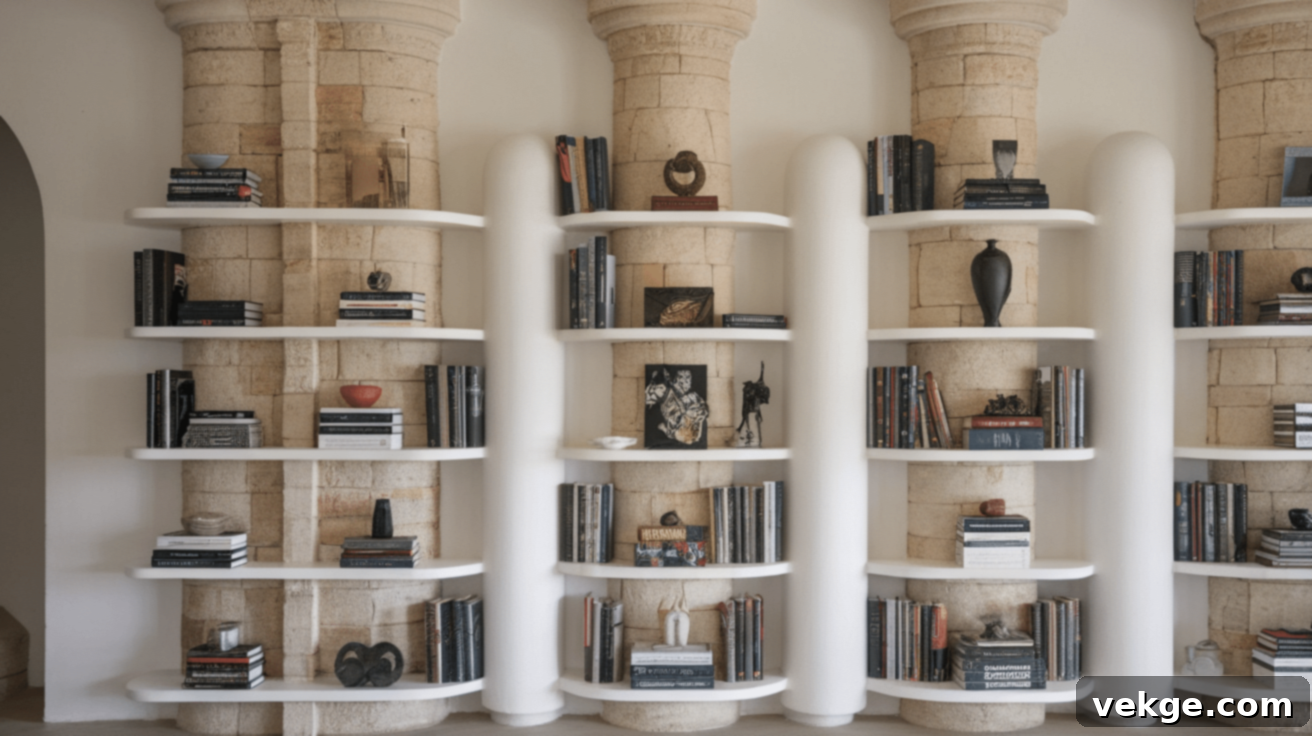
Maximize the utility of your columns by transforming them into practical and attractive storage solutions. Adding shelves between or around columns creates bespoke display areas for books, cherished collectibles, or decorative objects. Built-in bookcases that seamlessly incorporate columns offer expansive storage while adding architectural depth. Some innovative designs even feature recessed niches directly within the column structure itself, perfect for showcasing a piece of art or a treasured item. This approach brilliantly merges form and function, turning necessary structural elements into practical and stylish storage solutions.
9. Columns with Built-In Lighting
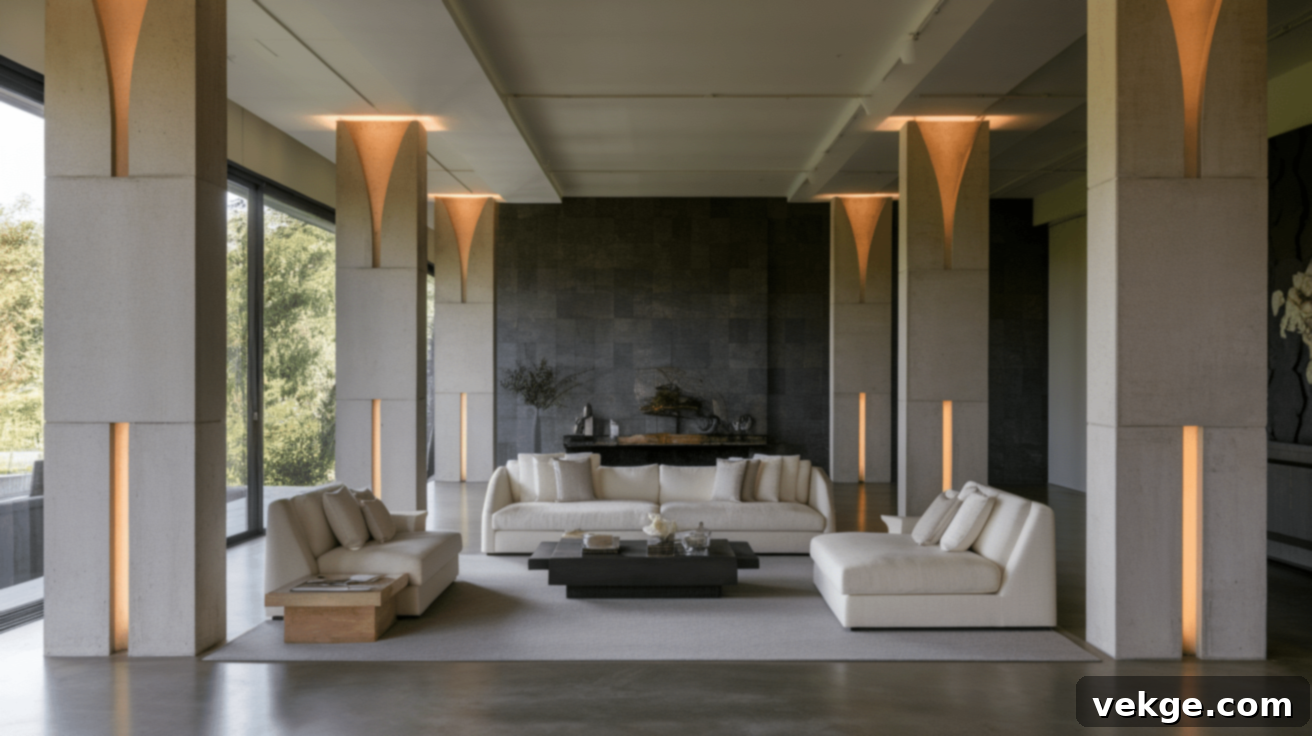
Illuminate your space and enhance architectural details by integrating lighting directly into your columns. Options range from subtle recessed lights within the column structure, strip lighting along its edges to create a soft glow, or elegant sconces mounted directly onto the column faces. This built-in lighting not only highlights the column’s texture and form but also provides useful ambient or accent illumination for the room. It can create dramatic effects in the evening, define pathways, or even eliminate the need for cumbersome floor or table lamps, contributing to a clean and sophisticated aesthetic.
10. Column Supports for Staircases
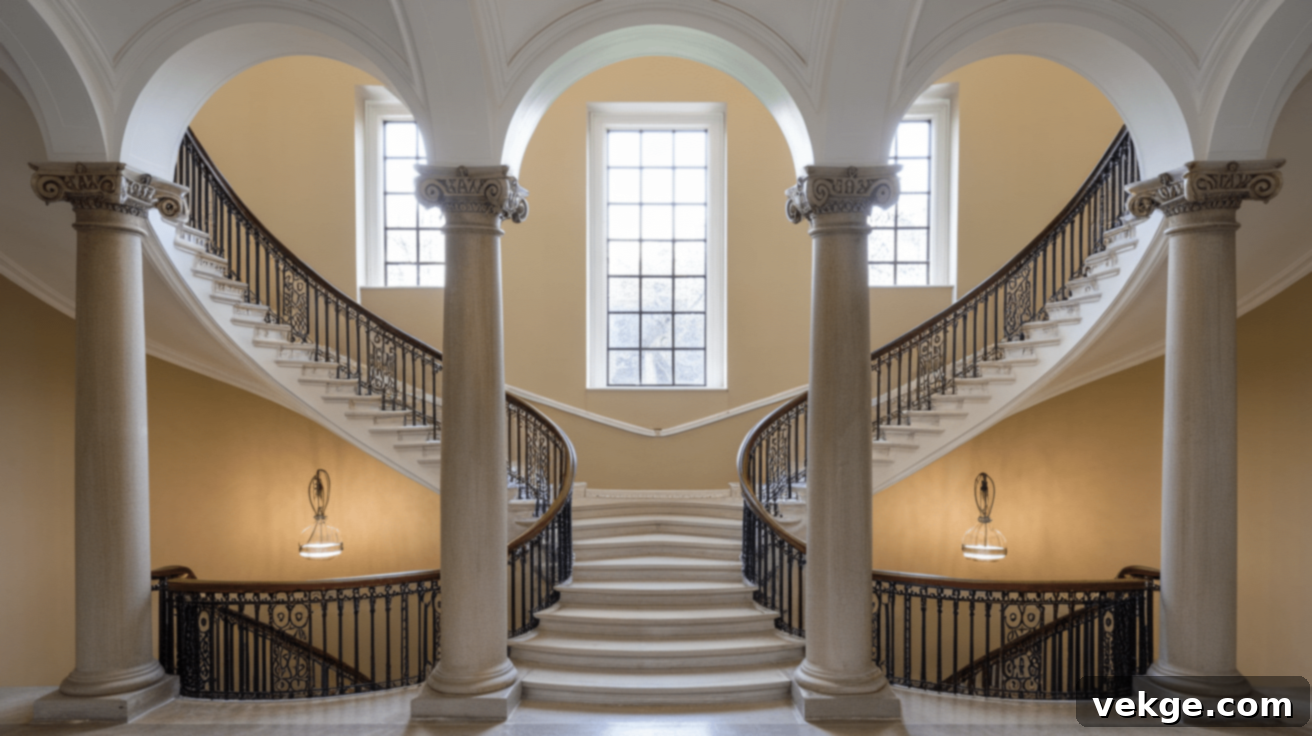
Columns playing a supporting role for staircases can anchor banisters, provide robust support for landings, and add a striking visual rhythm to your home’s vertical circulation. Whether simple and understated or elaborately ornate, these columns help to define your staircase as a significant architectural feature. Well-designed stair columns become an integral part of the journey between floors, guiding movement and enhancing safety, all while contributing to the overall design narrative. Their style should ideally complement both the design of your stairs and the overarching aesthetic of your home, creating a harmonious transition.
11. Faux Columns in Smaller Spaces
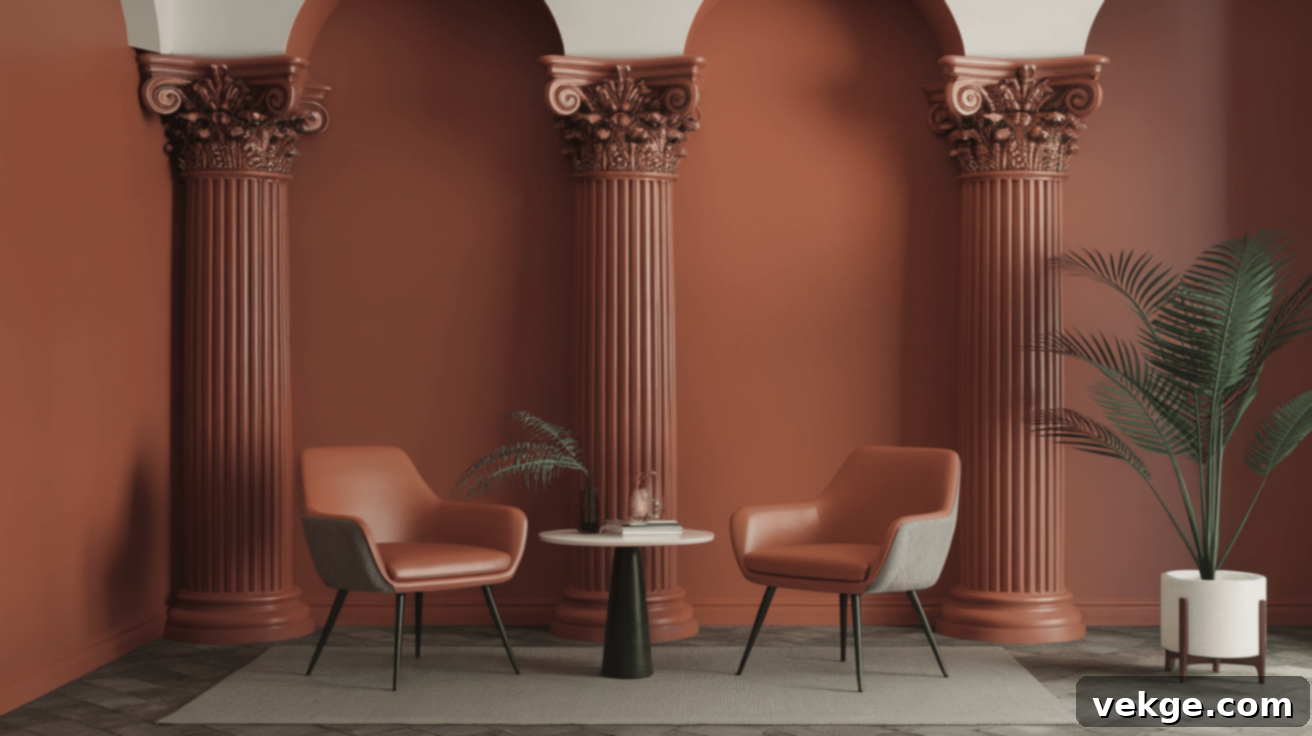
Even small spaces can benefit from the architectural interest of columns without sacrificing precious floor area. This is where half-columns or shallow pilasters shine. These slim profiles offer the visual impact and formality of full columns while remaining close to the wall, adding depth and character without making the room feel crowded. Properly scaled faux columns introduce structure and style to modest rooms, providing a touch of classic elegance or modern sophistication without overwhelming the space. They are an ingenious way to introduce architectural detail where space is a premium.
12. Using Columns in Bathrooms
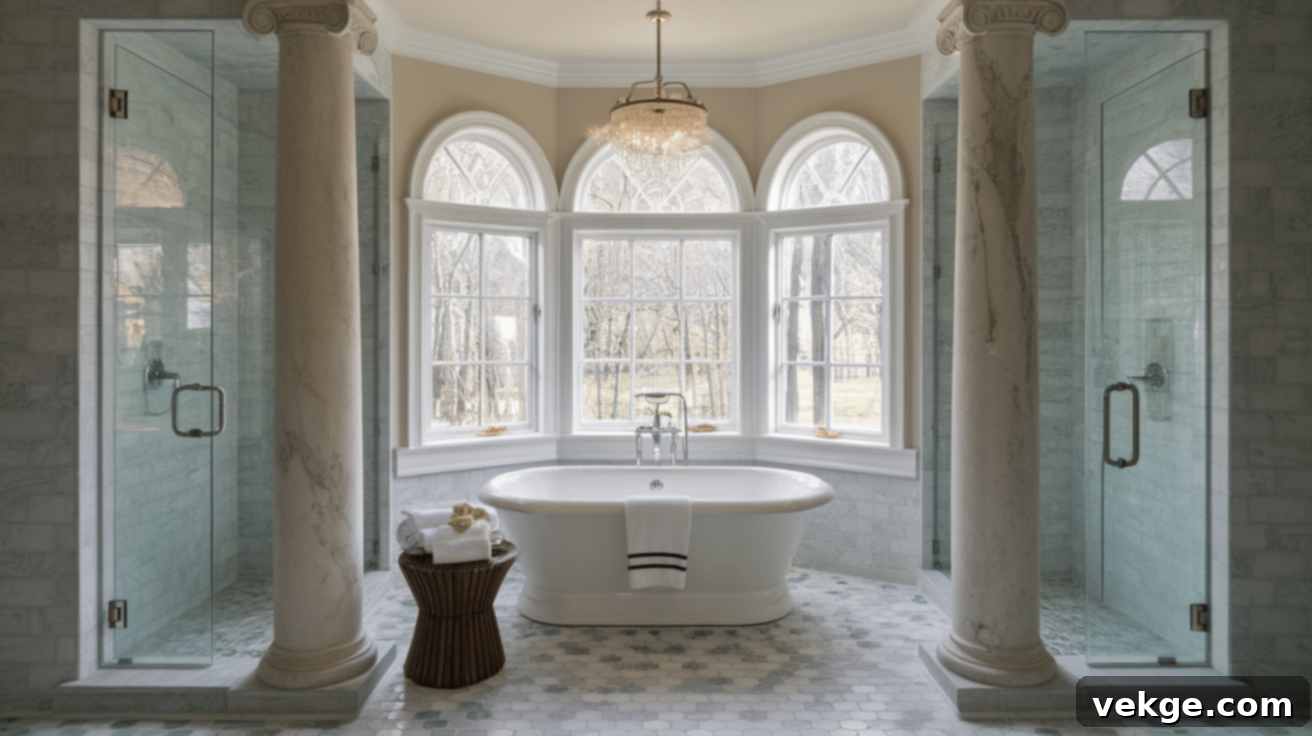
Introducing columns into bathrooms adds an unexpected touch of luxury and architectural sophistication to these practical spaces. They can elegantly frame a freestanding soaking tub, define the entrance to a spacious shower, or create structural interest in larger master bathrooms. When choosing materials, opt for weather-resistant options like stone, tile, treated wood, or moisture-resistant composites to withstand the humid environment. Consider columns with built-in niches or shelving for convenient storage of towels, bath products, or decorative items, blending opulence with essential functionality.
13. Column Cladding for a Stylish Look

For existing, plain structural columns that don’t align with your design vision, decorative cladding offers a transformative solution. This involves applying a new surface material to completely change their appearance without major construction. Options include sophisticated stone veneer, warm wood panels, intricate tiles, sleek metal sheeting, or textured wall coverings. This approach allows you to seamlessly integrate columns into your chosen design style, effectively hiding utilitarian supports and turning them into intentional, stylish features that complement your overall decor.
14. Outdoor Columns for Indoor Spaces
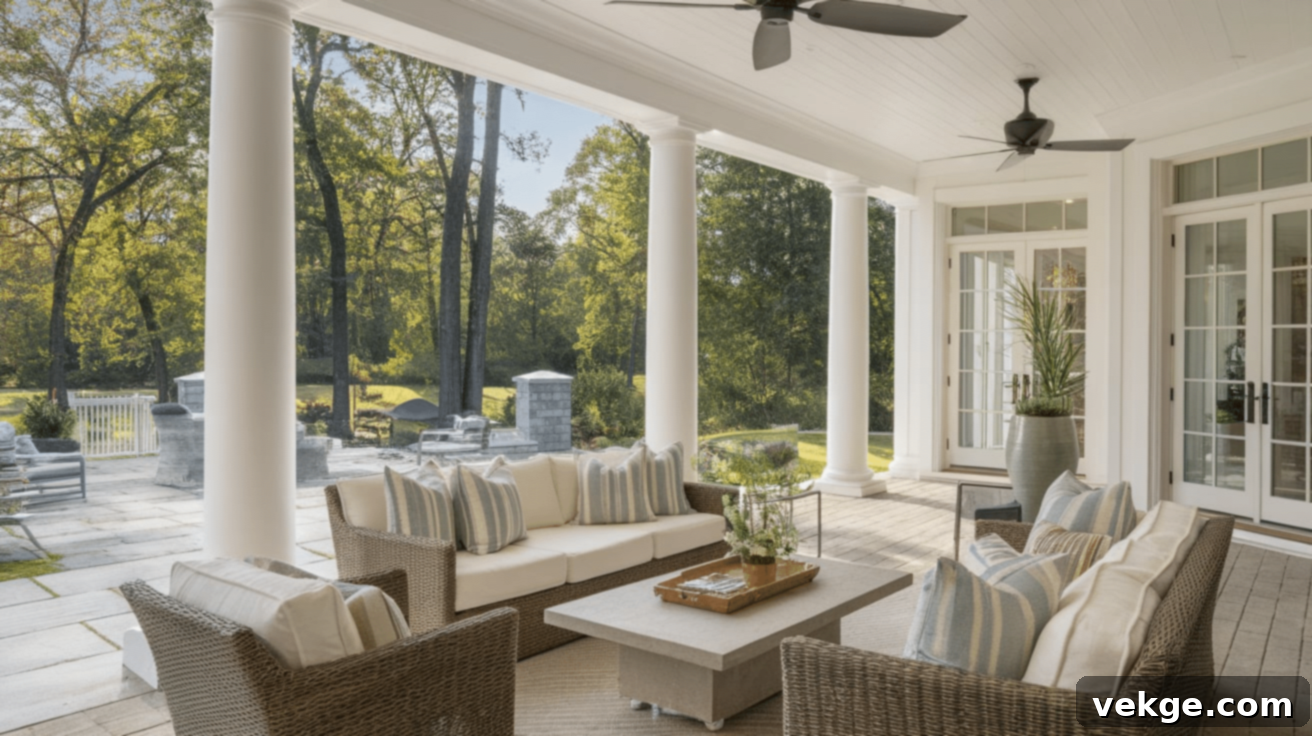
Bring the beauty and robustness of outdoor column styles indoors to create unique spaces with a strong connection to nature. Columns crafted from natural stone, reclaimed brick, or those featuring organic motifs like leaf carvings can make sunrooms, garden-facing areas, or indoor-outdoor living spaces feel seamlessly linked to the exterior environment. This design approach works particularly well in homes that blur the lines between indoor and outdoor living, fostering smooth transitions and a cohesive, biophilic design aesthetic.
15. Columns in Home Theaters
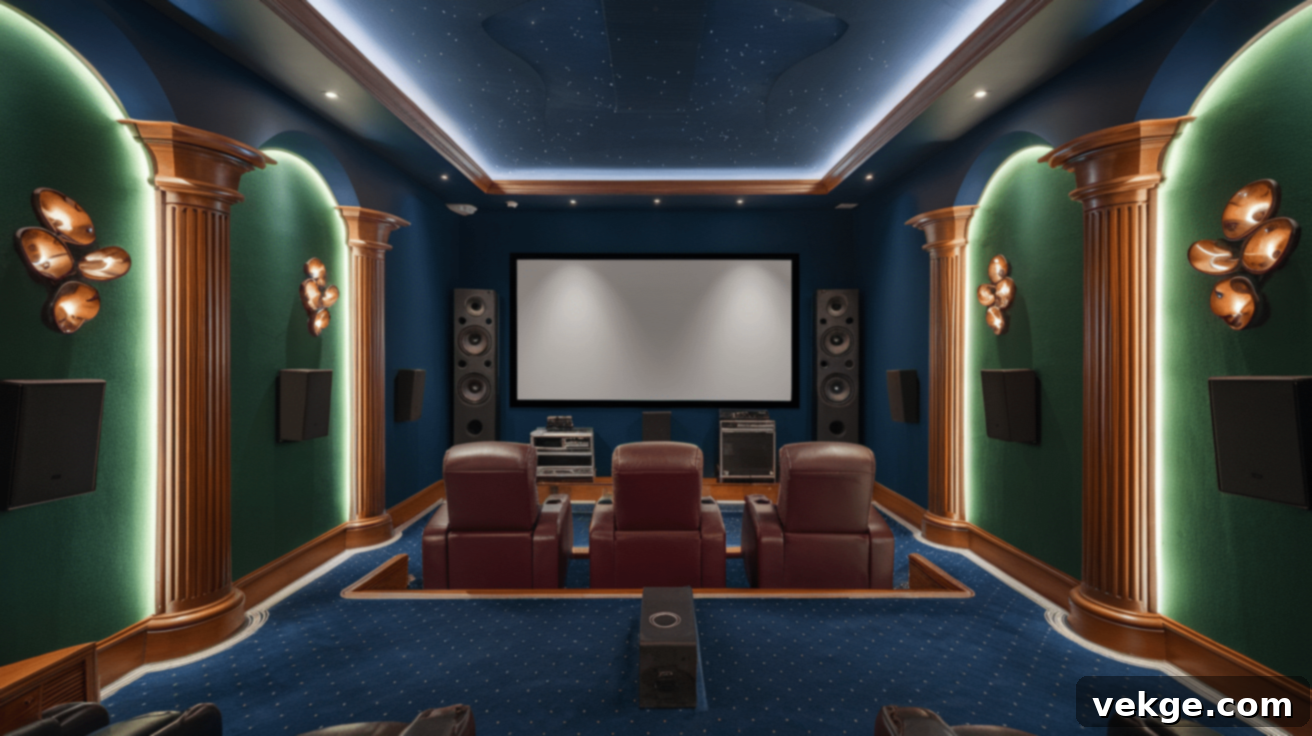
In a home theater, columns can contribute both to the functional performance and the immersive cinematic atmosphere. They can ingeniously house speakers and conceal wiring, ensuring a clean and professional setup. Strategic placement can also significantly improve room acoustics by breaking up sound waves, while their classic forms can evoke the grandeur of traditional movie palaces. Consider columns with integrated fabric panels for enhanced sound absorption or those with built-in, dimmable lighting to achieve that true theater experience for unforgettable movie nights.
16. Incorporating Column Details in Hallways
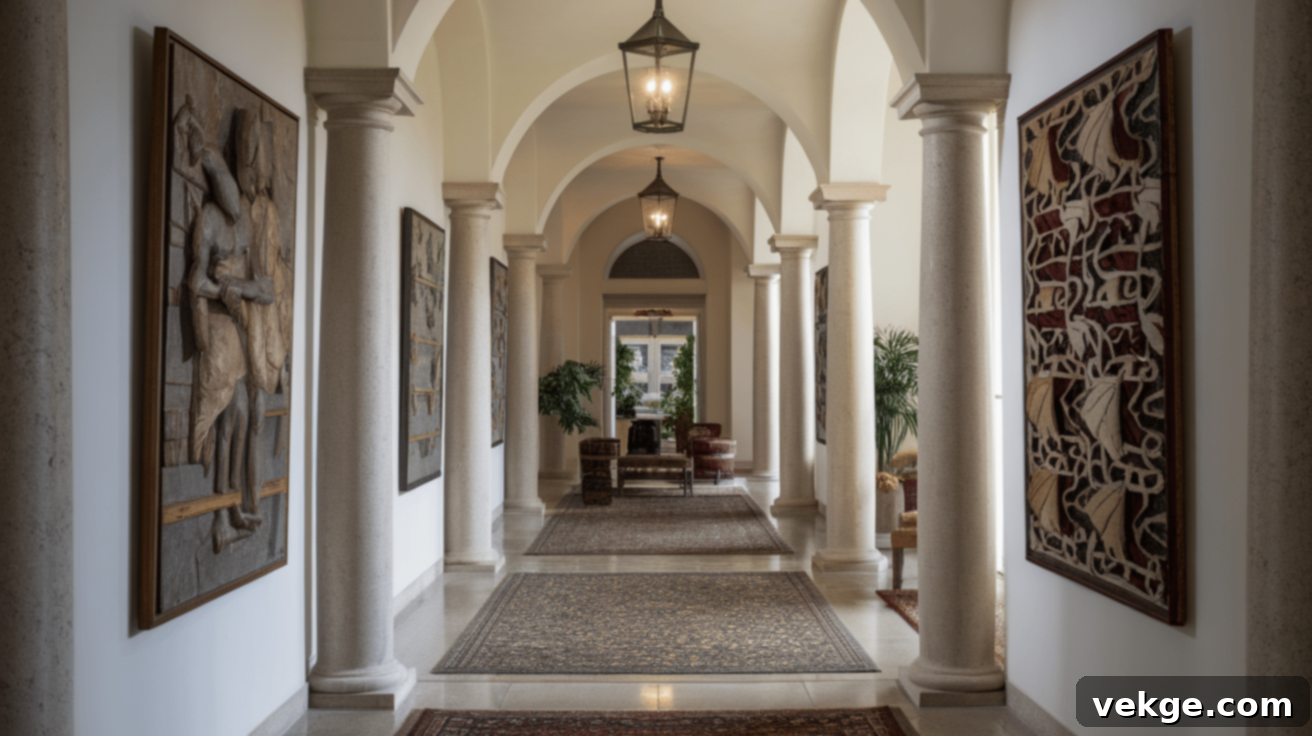
Long, unadorned hallways can often feel monotonous. Introducing column details, even in the form of slim half-columns or pilasters, can dramatically break up these corridors and create a visually engaging rhythm. They can subtly mark doorways, create elegant nooks for small console tables or art displays, or simply add architectural interest to otherwise plain passages. Placed at regular intervals, even understated column details add depth, character, and a sense of refined progression to these often-overlooked transitional spaces.
17. Creating a Column Focal Point in Bedrooms
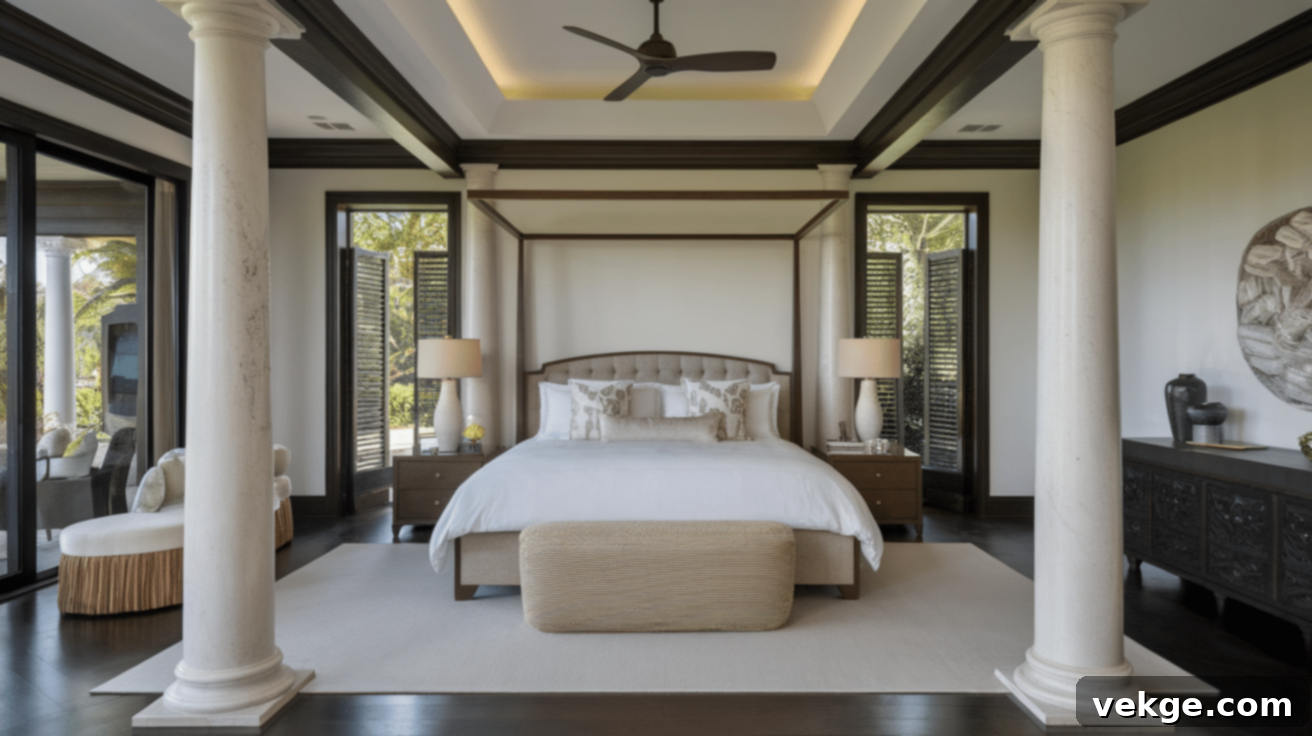
In the sanctuary of the bedroom, columns can introduce a sense of luxury, permanence, and dramatic flair. They can beautifully frame the headboard, creating a grand backdrop for your bed, or be used to construct elegant canopy structures for a truly opulent feel. In larger master suites, columns can also define distinct sitting areas or delineate a luxurious dressing zone. Matched pairs flanking the bed create a sophisticated, hotel-like atmosphere of structured elegance, elevating the room beyond basic furnishings to a realm of refined comfort and style.
18. Integrating Columns into Multi-Story Spaces
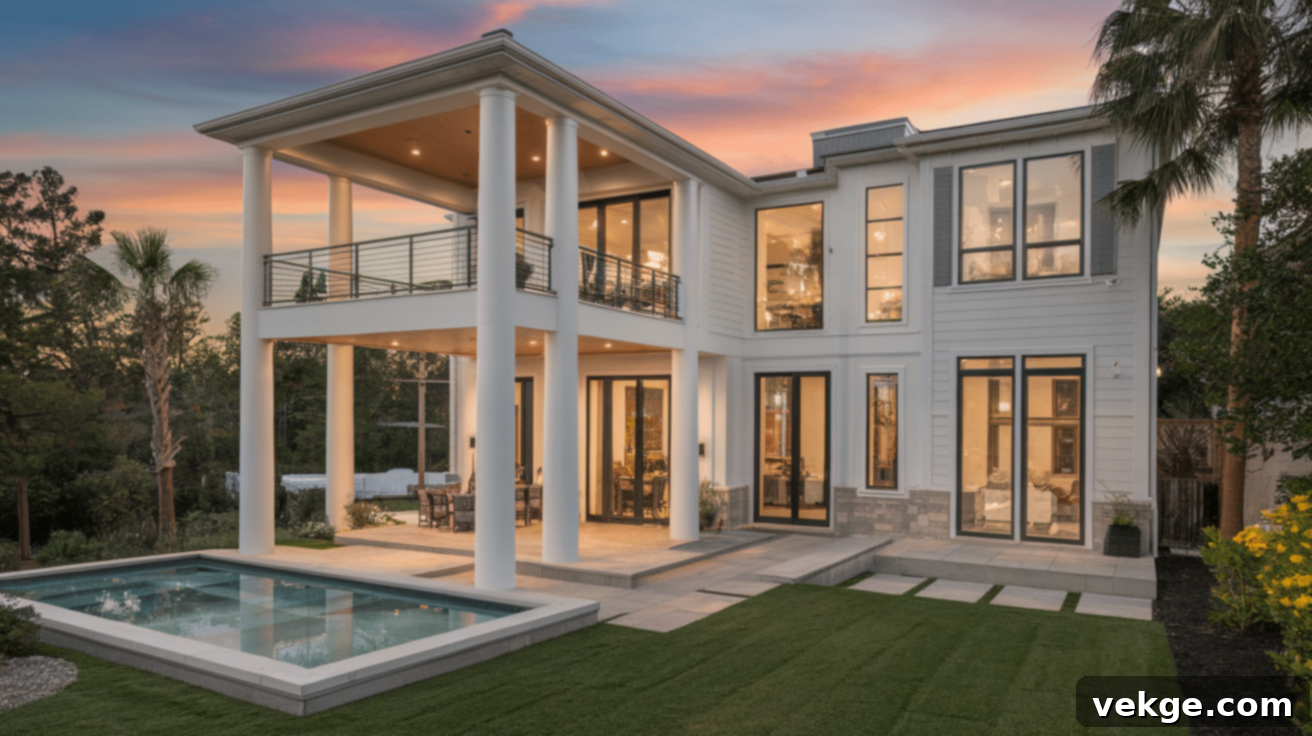
In homes featuring open, two-story areas or soaring ceilings, columns are vital for creating visual continuity and scale. They effectively guide the eye upward, emphasizing ceiling height and providing a sense of proportion to these expansive volumes. When consistently used between floors, columns unite different levels, preventing the space from feeling overwhelmingly vast or disconnected. Their strong vertical lines not only highlight the impressive height but also provide necessary structural support in an aesthetically pleasing and architecturally significant manner, making the space feel both grand and cohesive.
19. Repurposing Old Columns for Modern Design
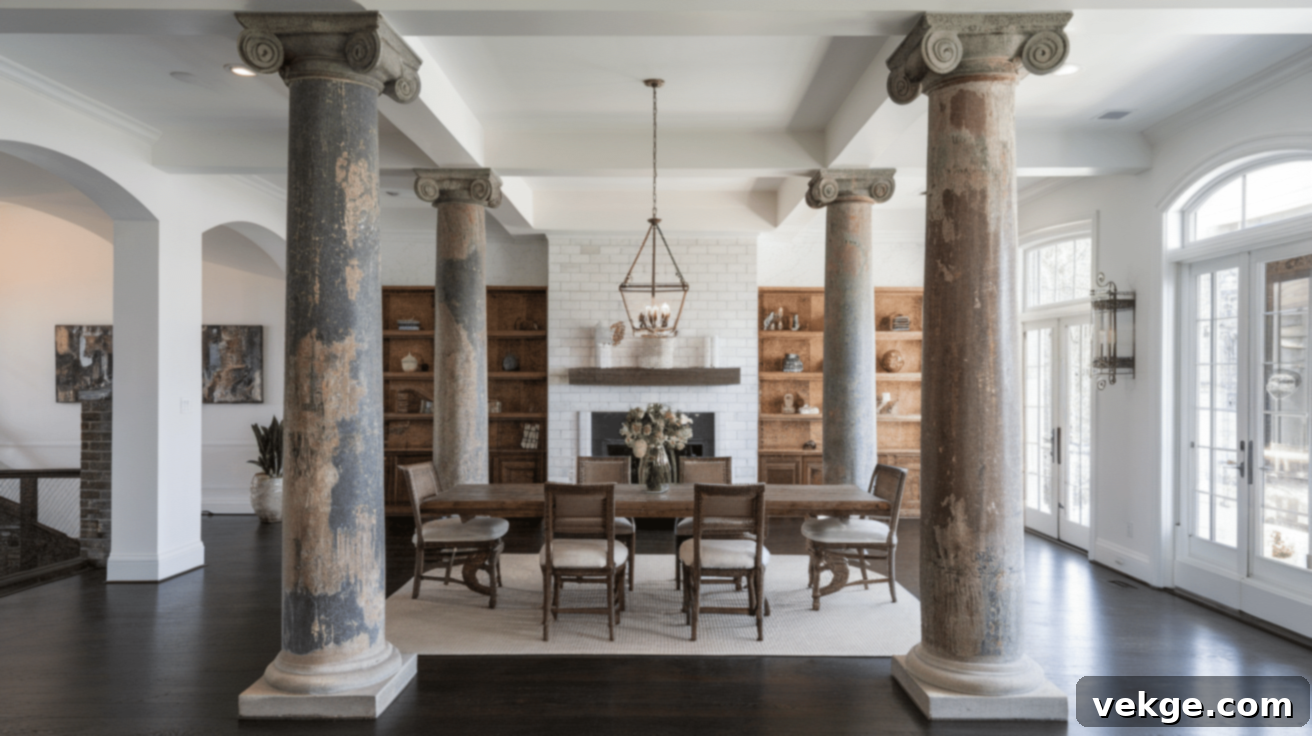
Salvaged columns from older buildings offer a unique opportunity to infuse character and history into contemporary spaces. Their weathered patina, inherent imperfections, and historical details create an intriguing contrast amidst sleek, modern furnishings. Consider using these repurposed pieces as standalone sculptural art, cutting sections to serve as distinctive table bases, or installing them in unexpected locations like a minimalist bathroom or kitchen to introduce a rich textural and historical counterpoint. This approach celebrates sustainability and creates truly one-of-a-kind design statements.
20. Adding Columns Around Doors or Windows
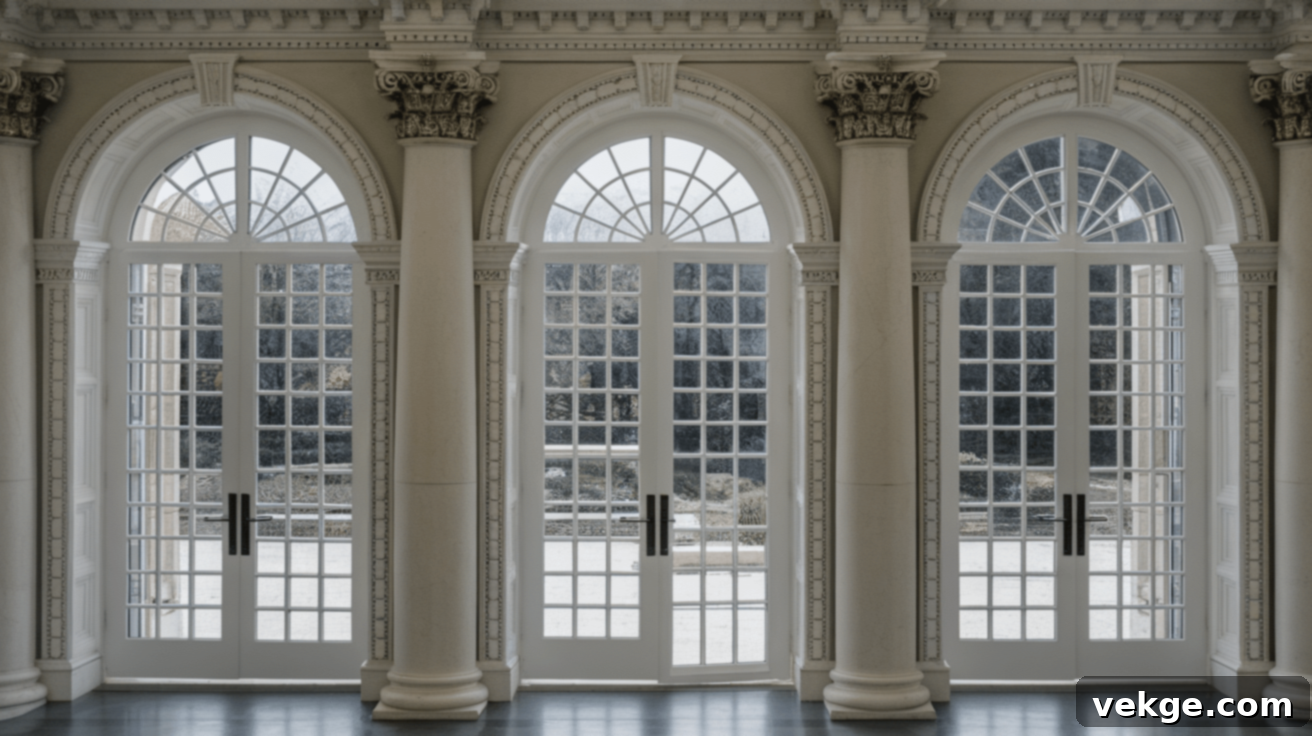
Framing doors or windows with columns imbues these openings with a stately presence and architectural significance. This treatment draws immediate attention to impressive views or important entryways, adding visual weight and a sense of formality to otherwise simple wall openings. Depending on the desired emphasis, the columns can be designed to subtly blend with the surrounding wall colors for an understated elegance, or they can stand out as contrasting elements, making a bold architectural statement. This detail enhances both curb appeal and interior grandeur.
21. Mixing Columns with Archways
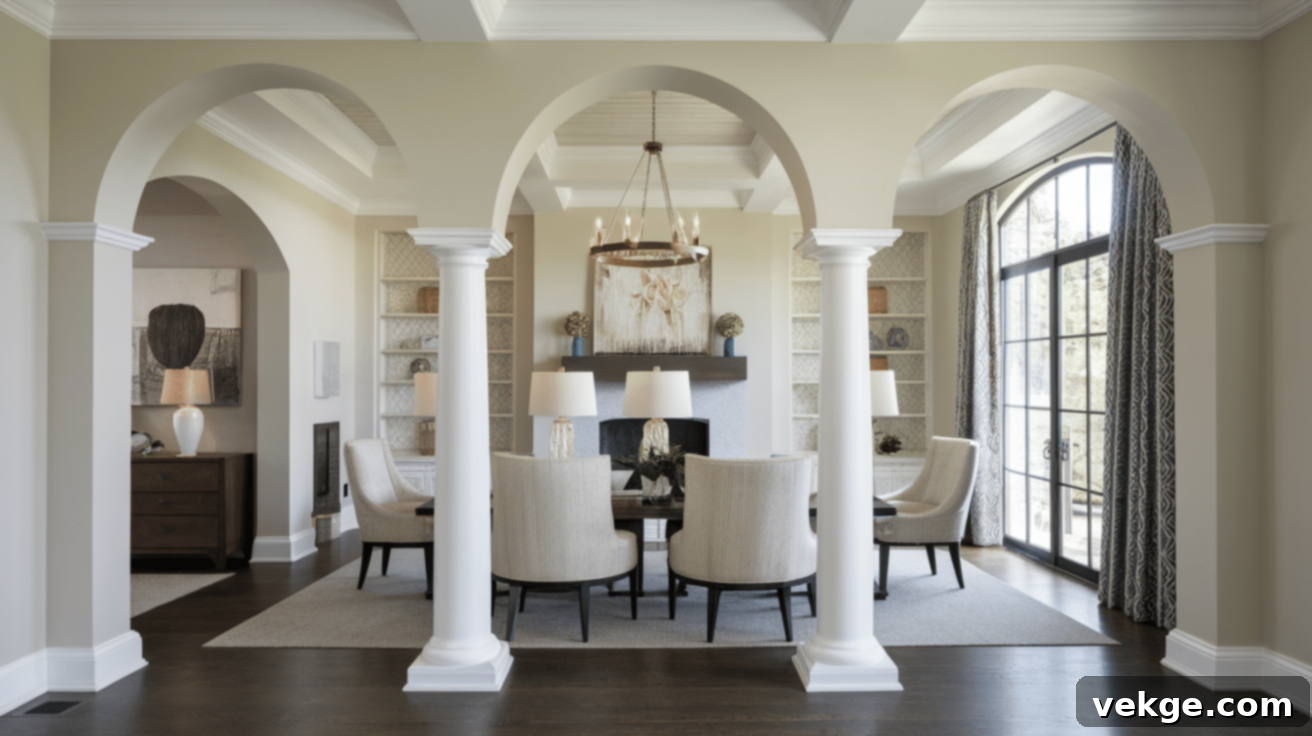
The combination of columns supporting elegant arched openings creates classic, timeless transitions between rooms. This pairing results in spaces that feel both open and distinctly defined, drawing inspiration from historical architecture while remaining perfectly adaptable to many modern contexts. It adds impressive height, visual depth, and a sense of permanence to doorways, transforming them into majestic portals. This design choice maintains excellent sightlines between spaces, fostering a harmonious flow while adding an undeniable touch of grandeur and sophisticated architectural detail.
22. Use Columns to Frame a Bar Area
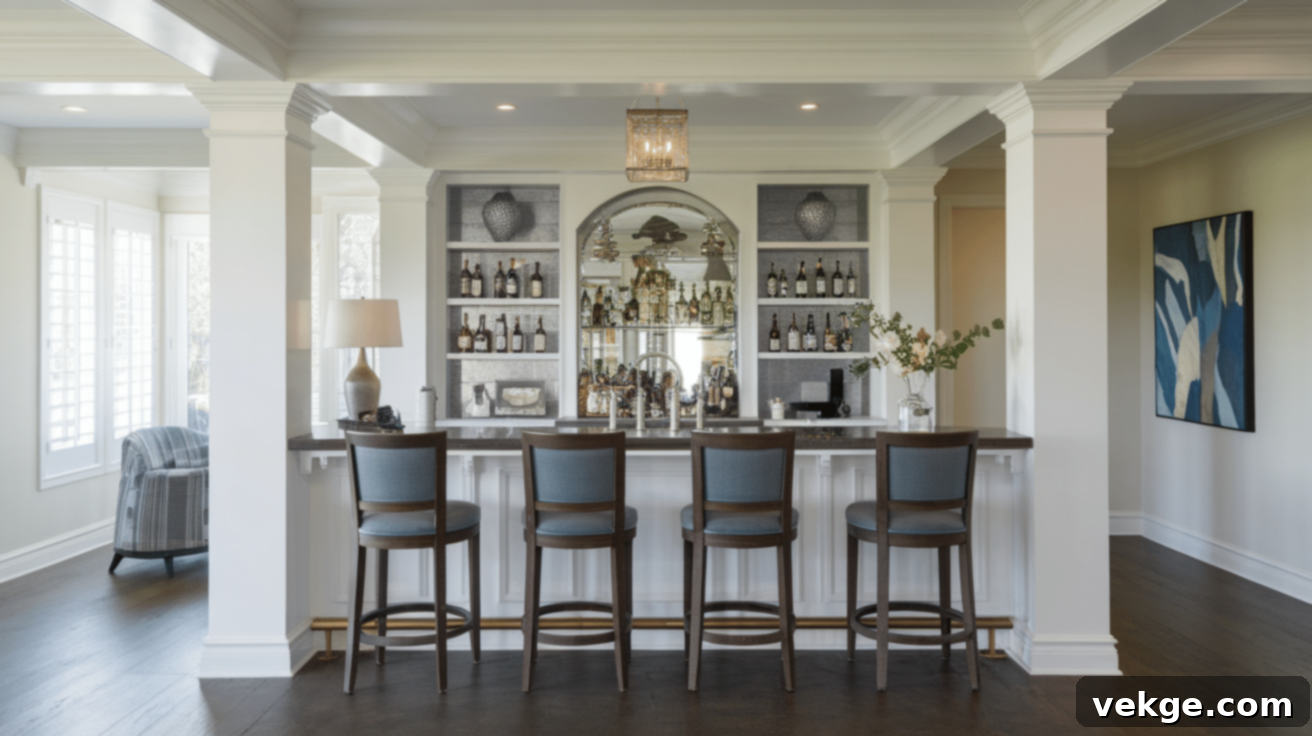
For home entertaining, columns can effectively delineate a dedicated bar area, marking it as a special and inviting zone distinct from the surrounding spaces. They can elegantly support countertops, provide natural endpoints for bar seating, or be cleverly designed to house built-in wine racks, glass storage, or even a small beverage fridge. These vertical elements add crucial structure to what might otherwise feel like just another counter, helping to define the bar as a sophisticated gathering spot where guests can socialize and enjoy drinks in a well-appointed setting.
23. Columns as a Feature in Mudrooms
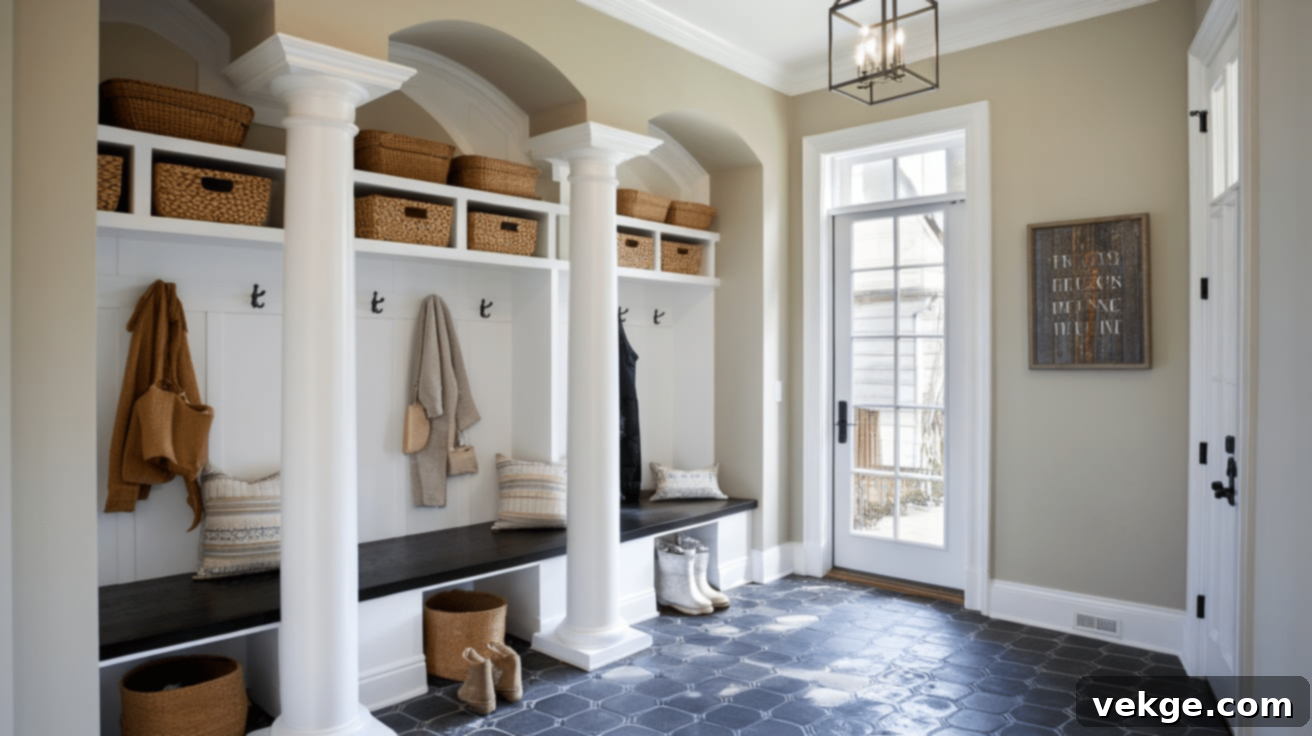
Often overlooked, mudrooms can benefit immensely from the addition of architectural detail. Columns, even in a simplified form, can bring unexpected style to these highly functional spaces. They can effectively mark the transition from the outdoors to the interior, support bench seating for convenience, or create natural divisions for dedicated coat storage and shoe cubbies. Even in these practical utility areas, well-chosen columns add a thoughtful touch of design that not only enhances the room’s aesthetics but also offers a more welcoming return home for family members and guests alike.
24. Support Columns in Loft Spaces
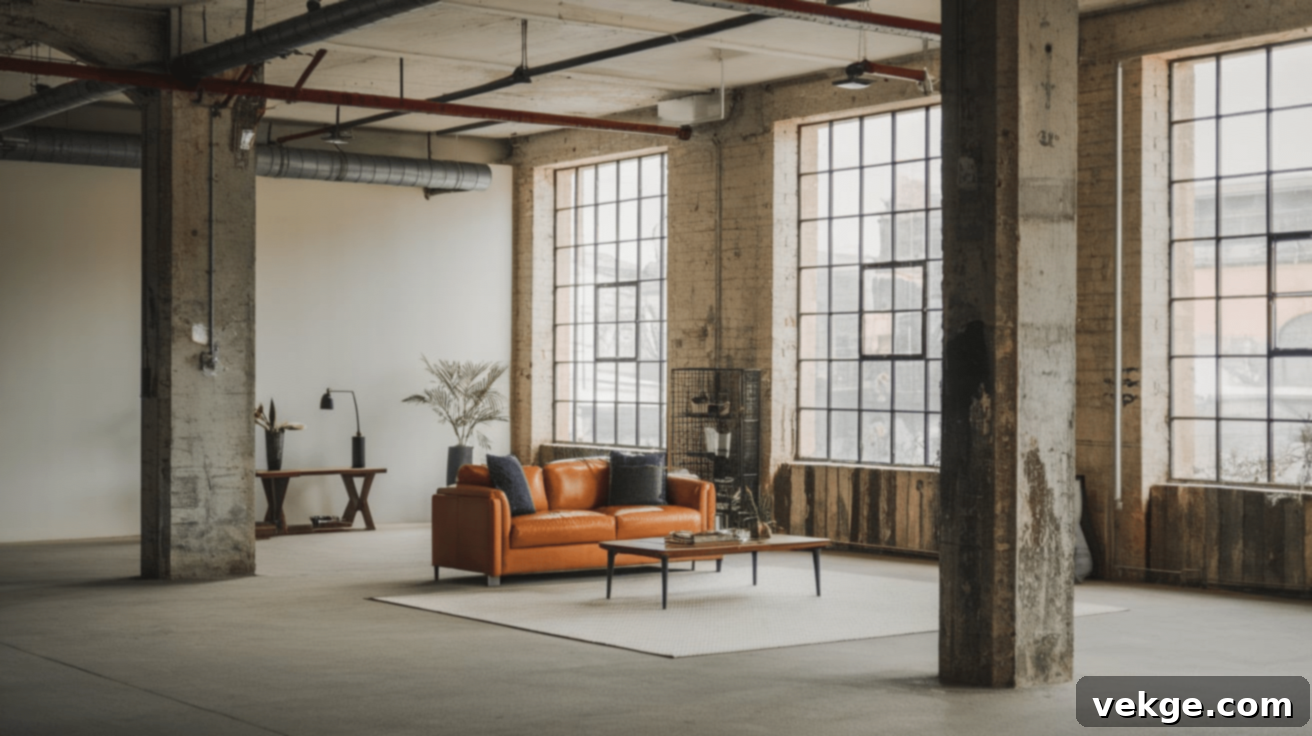
In contemporary loft-style homes, exposed support columns are often embraced as integral elements of the industrial aesthetic. Rather than attempting to conceal these structural necessities, the design intention shifts to highlighting them. This can be achieved by painting them in contrasting colors that draw attention, or by cladding them in complementary raw materials like concrete, unfinished wood, or metal. Their honest functionality becomes a celebrated part of the overall design statement, harmonizing beautifully with other raw elements such as exposed brick walls, visible ductwork, and high ceilings.
25. Create Symmetry with Paired Columns
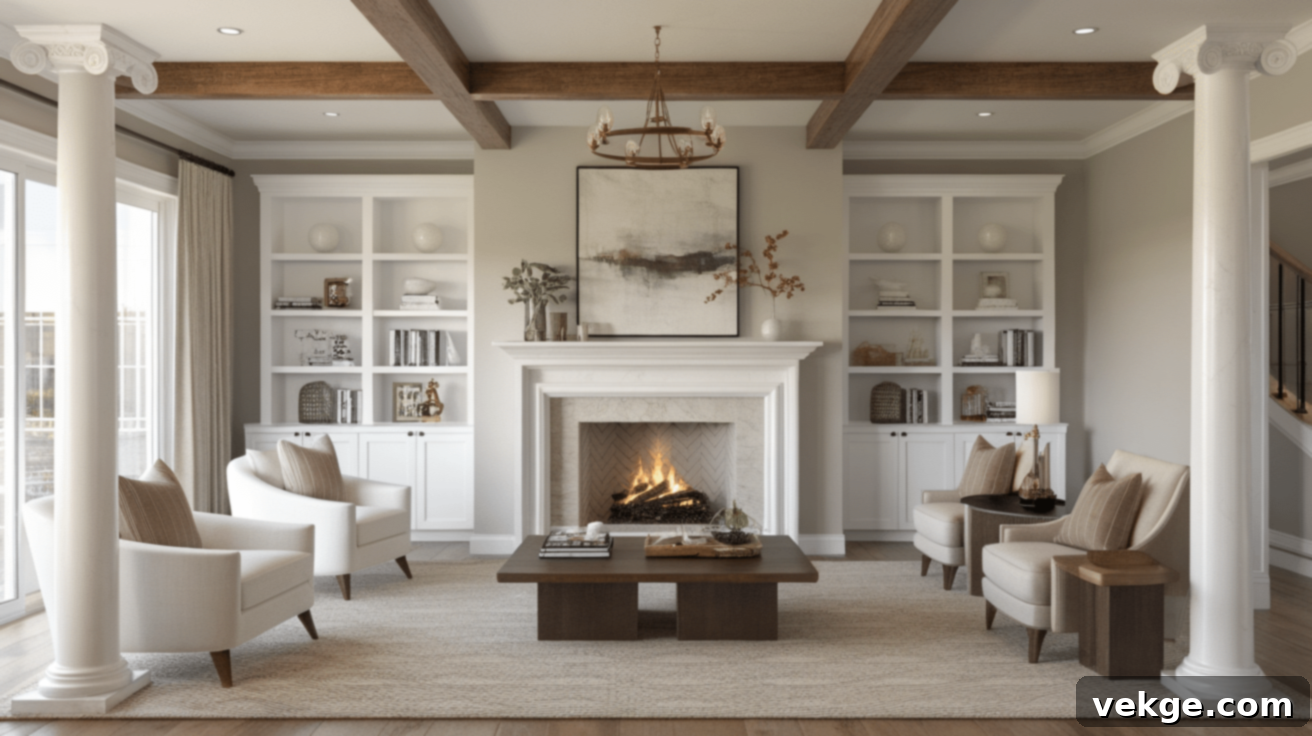
Matched pairs of columns are a classic design principle for instilling balance, formality, and grandeur in interior spaces. Strategically placed on either side of key focal points—such as a prominent fireplace, a grand entryway, or expansive windows—they effectively frame these features with classical symmetry. This arrangement not only brings a powerful sense of order and intentionality to room layouts but also subtly guides the eye toward important design elements, creating a visually harmonious and deeply satisfying aesthetic that feels both traditional and elegantly structured.
26. Minimalist Column Designs for Modern Spaces
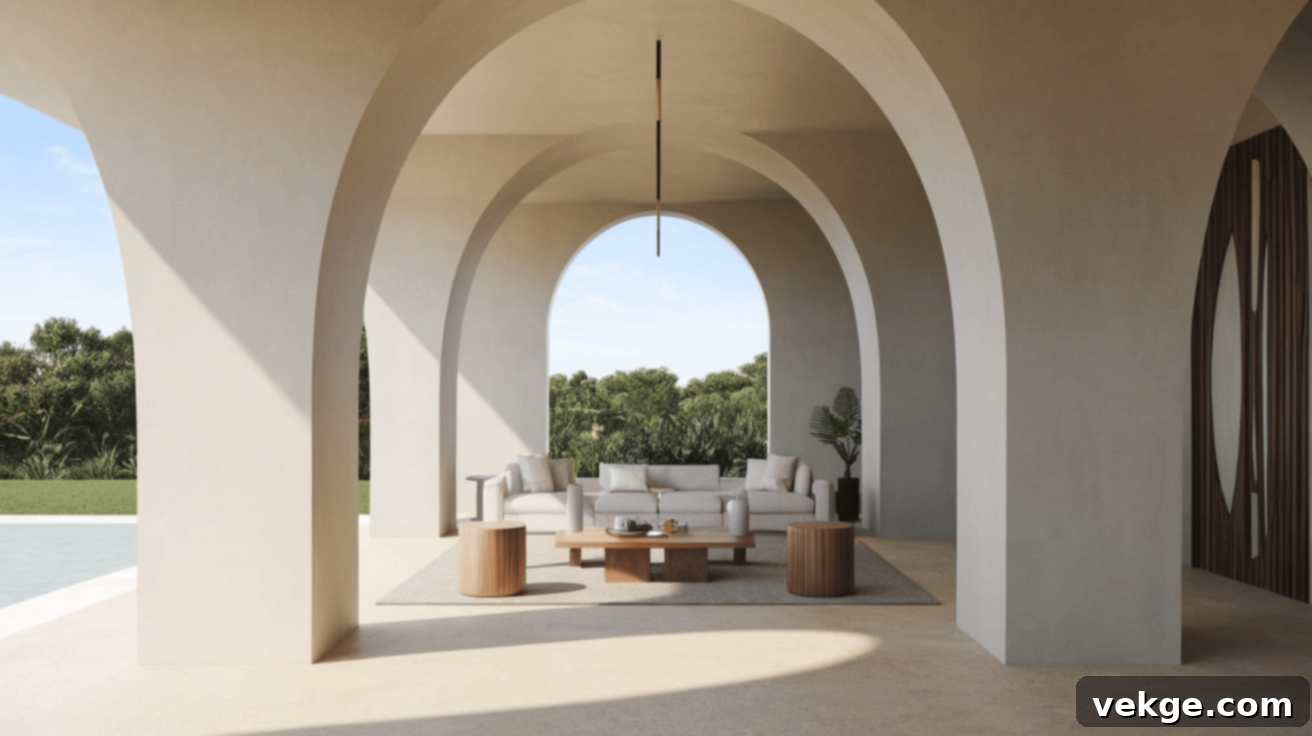
For homes embracing a contemporary or minimalist aesthetic, clean-lined, simple columns devoid of ornate details are the perfect choice. Square or round columns featuring minimal caps and bases provide essential structure without introducing any visual clutter. These understated designs excel in modern spaces where their pure forms can be fully appreciated against simple, uncluttered backgrounds of glass, polished concrete, or smooth, monochromatic walls. They contribute to an airy, sophisticated environment, emphasizing form and function without distraction.
27. Statement Columns with Bold Colors or Patterns

Transform functional columns into dynamic conversation pieces by applying unexpected and bold finishes. Paint them in striking colors that vividly contrast with the surrounding walls, wrap them in eye-catching patterned wallpaper, or adorn them with artistic mosaic tiles. This adventurous approach elevates purely structural elements into vibrant artistic statements that immediately draw the eye and inject significant personality and flair into your home design. It’s an excellent way to express individuality and create unforgettable focal points.
Column Materials and Finishes
The material and finish you select for your interior columns profoundly influence both their functional properties and their overall visual impact. From time-honored natural wood to sleek modern alternatives, each option presents a unique set of benefits, cost implications, and aesthetic effects that will shape your home’s design. Understanding these diverse choices is crucial for making informed decisions that align with your personal style, budget, and the practical requirements of your living space.
Wood Finishes for Traditional Columns
Wood columns inherently bring natural warmth, an organic texture, and a timeless appeal to traditional and transitional interiors. Different wood species offer distinct characteristics: Oak provides visible, robust grain patterns; maple delivers a smoother, finer grain suitable for painting or light staining; cherry offers rich, reddish-brown tones that deepen beautifully with age; and pine serves as a cost-effective option, particularly when painted or heavily stained. Each type can be further customized with stains, varnishes, or sealants to protect the wood and enhance its inherent beauty, ensuring longevity and a perfect match for your decor.
Faux Wood Columns for Budget-Friendly Projects
Faux wood columns are an exceptional solution for achieving the aesthetic of real wood without the higher cost, weight, or intensive maintenance. Constructed from durable materials such as PVC, polyurethane, or composite blends, these lightweight options boast superior resistance to warping, cracking, moisture damage, and insect infestations. They are typically supplied ready-to-paint and are remarkably easy to install, often designed with hollow centers that can conveniently encase existing structural supports. Many contemporary faux wood columns feature advanced texturing that convincingly mimics the authentic grain and feel of natural timber.
Metallic, Stone, and Resin Columns for Diverse Interiors
For contemporary, industrial, or highly customized spaces, non-traditional column materials offer immense design flexibility. Metal columns, crafted from steel, aluminum, or even copper, introduce an industrial flair with their clean lines and often reflective surfaces. Natural stone columns, whether polished marble, rustic limestone, or rugged granite, provide unparalleled grandeur, texture, and durability, ideal for creating a luxurious or earthy feel. Resin and fiberglass options are incredibly versatile, available in countless shapes, sizes, and finishes (including faux stone or metal), while being significantly lighter and more cost-effective than their natural counterparts. These modern materials generally require minimal upkeep and are highly resilient to varying indoor conditions.
Choosing the Right Material for Your Space
The selection of column materials should be a thoughtful process, guided by your room’s purpose, its prevailing style, and environmental conditions. Prioritize durability for high-traffic areas and ensure moisture resistance for humid spaces like kitchens or bathrooms. Strive to match columns with existing architectural elements, such as flooring, trim, and crown molding, to foster a cohesive and harmonious look. Carefully weigh the initial investment against long-term maintenance requirements. Finally, consider the complexity of installation—whether you need robust structural support or purely decorative elements will heavily influence your material choice.
Practical Considerations
While interior columns can significantly enhance your home’s beauty and architectural character, several practical factors must be meticulously considered before embarking on any installation. From intelligently disguising existing structural supports to precise placement and meticulous budget planning, these considerations are crucial for ensuring your column project is a resounding success, both functionally and visually.
Hiding Load-Bearing Columns
Existing load-bearing columns, though essential, don’t have to be unsightly. Simple yet effective design solutions can transform them into attractive features:
- Box them in: Encase the column with drywall or wood panels that seamlessly match your existing walls for a subtle, integrated look.
- Build around them: Integrate them into custom cabinetry or bookshelves, turning a structural necessity into valuable storage and display space.
- Clad them creatively: Depending on your home’s style, cover them with decorative wood, elegant stone veneer, modern metal panels, or even textured plaster to make them a deliberate design element.
- Simplify for blending: If you want them to recede, remove any elaborate trim or detailing that draws undue attention, opting for a clean finish that blends with the background.
Column Placement and Spacing Tips
The strategic placement of columns is paramount to their aesthetic and functional success:
- Define zones: Utilize columns to naturally segment open-concept spaces into distinct functional areas without the heaviness of full walls.
- Maintain symmetry: When using multiple columns, ensure they are evenly spaced and balanced to create a harmonious and deliberate flow.
- Frame entryways: Position columns to frame doorways or arches, instantly elevating their importance and creating a grander entrance.
- Match scale: Choose column sizes and proportions that are appropriate for the scale of your room and ceiling height to avoid an overcrowded or diminutive appearance.
- Preserve flow: Always place columns where they will not obstruct natural walking paths or block desirable views. Plan your furniture layout with columns in mind to ensure optimal room usage.
Thoughtful planning turns necessary structural supports into integral design features that significantly enhance your home’s visual appeal and functional layout.
DIY Column Ideas and Installation Tips
Many column projects can be successfully undertaken as DIY ventures, especially if they are non-load-bearing, with basic tools and intermediate skills:
- Pre-made column wraps: These offer the simplest installation method, designed to encase existing posts quickly and neatly.
- Use a level: Consistently use a level and plumb bob to ensure perfect vertical alignment for a professional finish.
- Secure non-load-bearing columns: Always securely fasten decorative or faux columns to both the floor and the ceiling to prevent wobbling and ensure stability.
- Choose lightweight materials: Opt for materials like PVC, polyurethane, or lightweight wood for easier handling and safer installation.
- Consult professionals: Crucially, never attempt to modify or remove load-bearing structures without first consulting a structural engineer or a qualified professional. Safety is paramount.
Conclusion
Interior columns are indeed powerful and often underestimated design elements that possess the ability to profoundly update the look and feel of any room. When thoughtfully selected and strategically incorporated, they transcend their basic structural role to add significant structure, refined style, and distinctive character to even the simplest of spaces. From the enduring charm of classic wooden designs to the sleek sophistication of modern minimalist styles, columns offer a wealth of both functional and visual benefits that can dramatically enhance your home’s aesthetic and practical appeal.
We encourage you to take the time to carefully analyze your rooms, identifying areas where columns could significantly improve spatial flow, elegantly define different zones, or simply introduce a compelling architectural appeal. Consider starting with smaller, decorative projects like pre-made column wraps to build confidence, before progressing to more intricate installations or structural modifications. With careful planning, a keen eye for design, and an understanding of the available options, the columns in your home can undoubtedly evolve into its most distinctive, admired, and functional features, reflecting your unique style and enhancing your everyday living experience.
Ready to explore more design possibilities? Dive into our other blogs for further inspiration and expert tips to fuel your next exciting home project.
